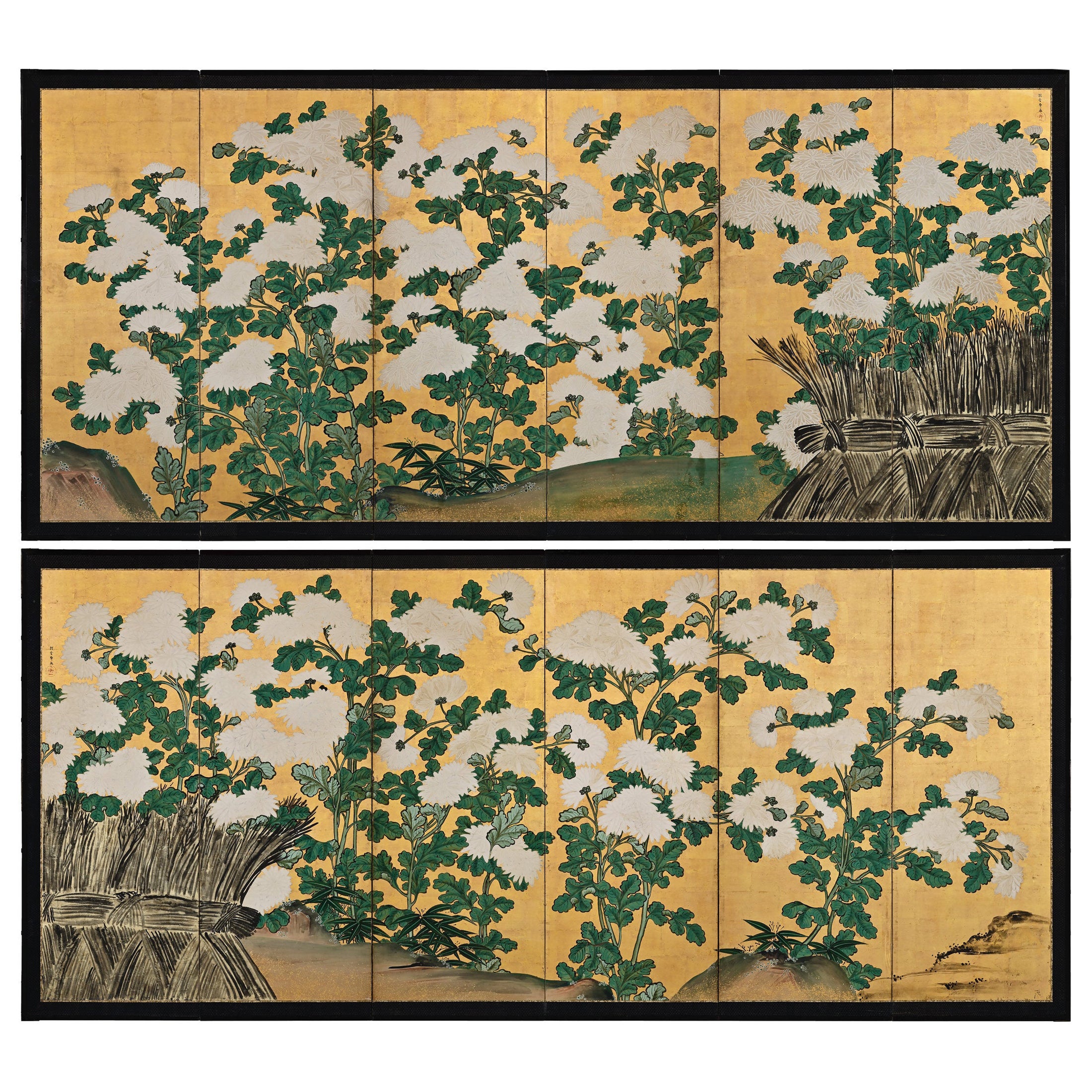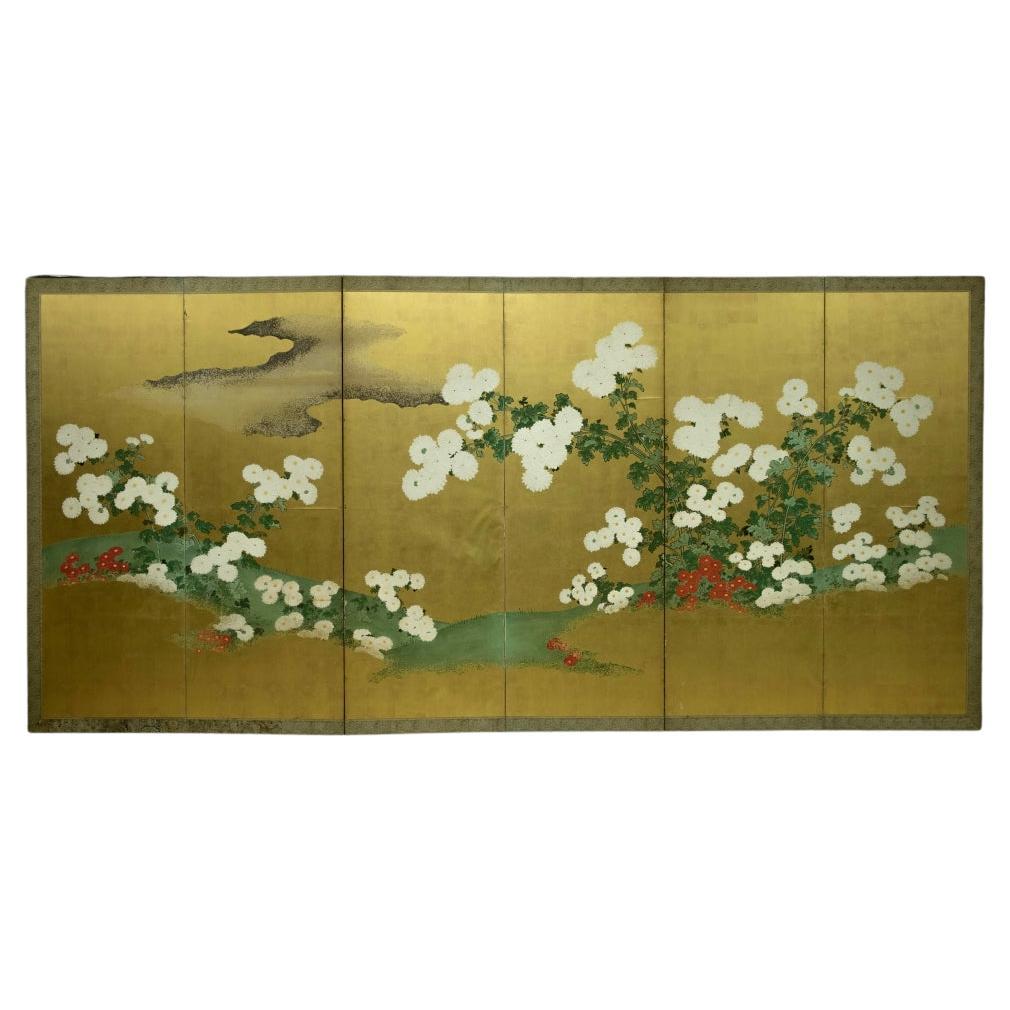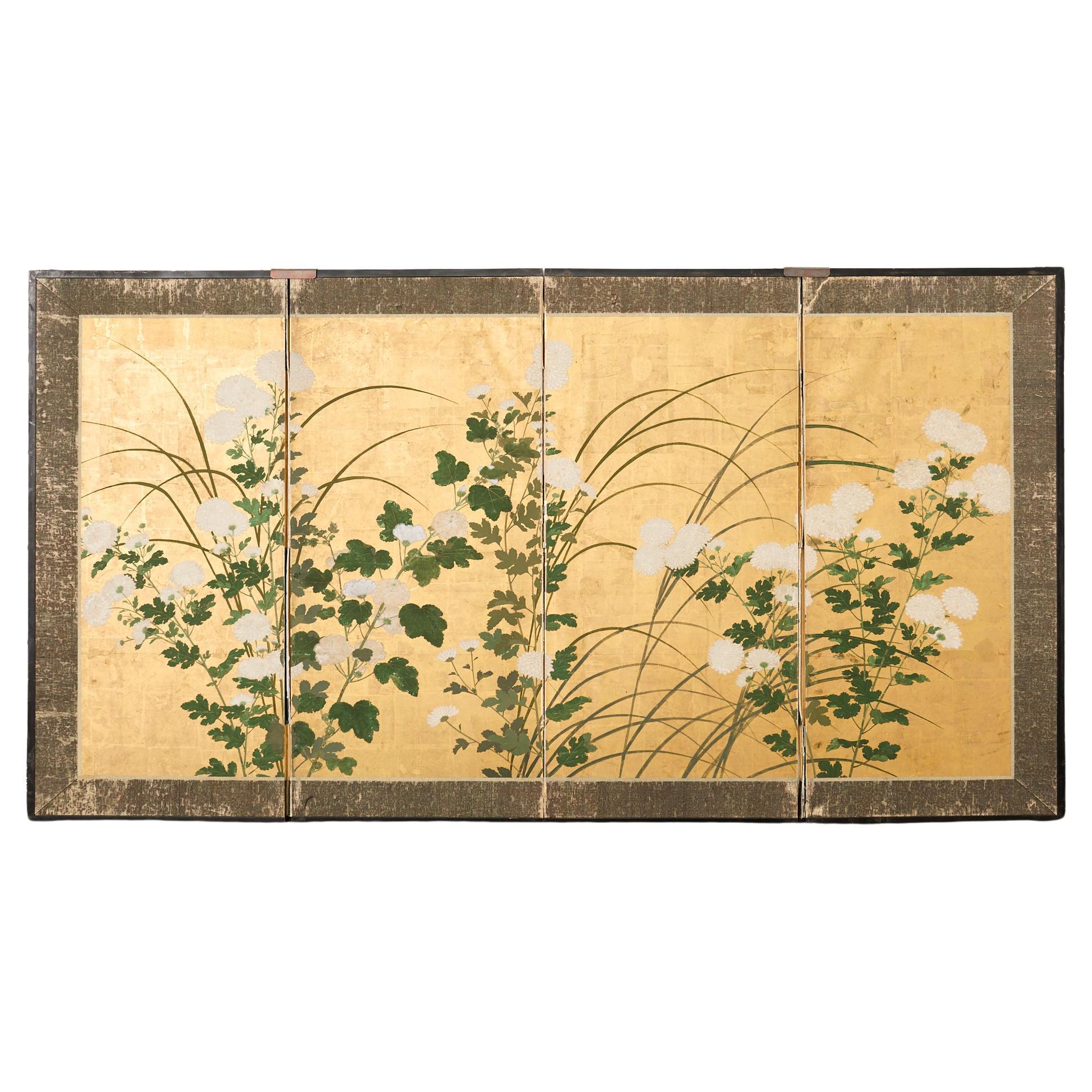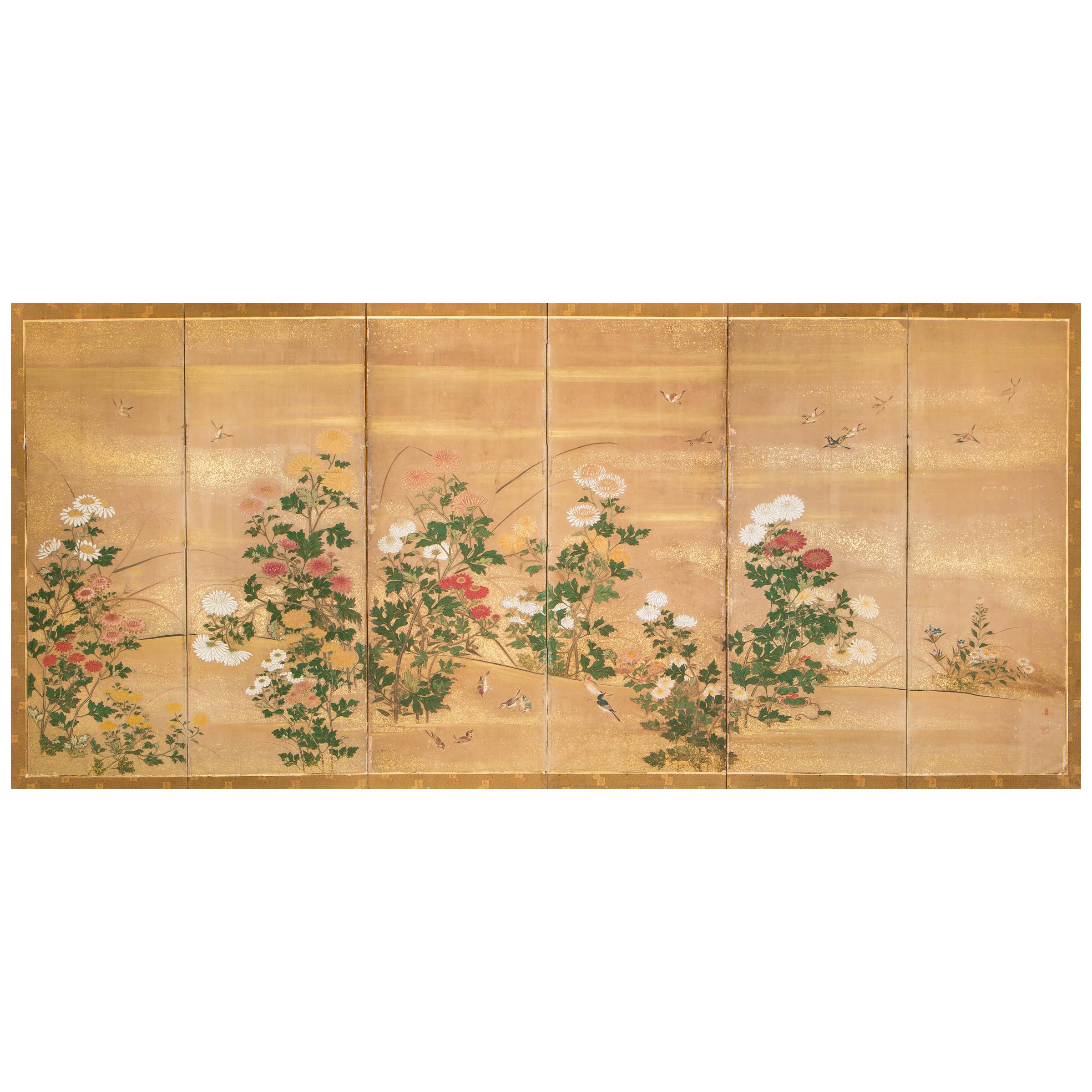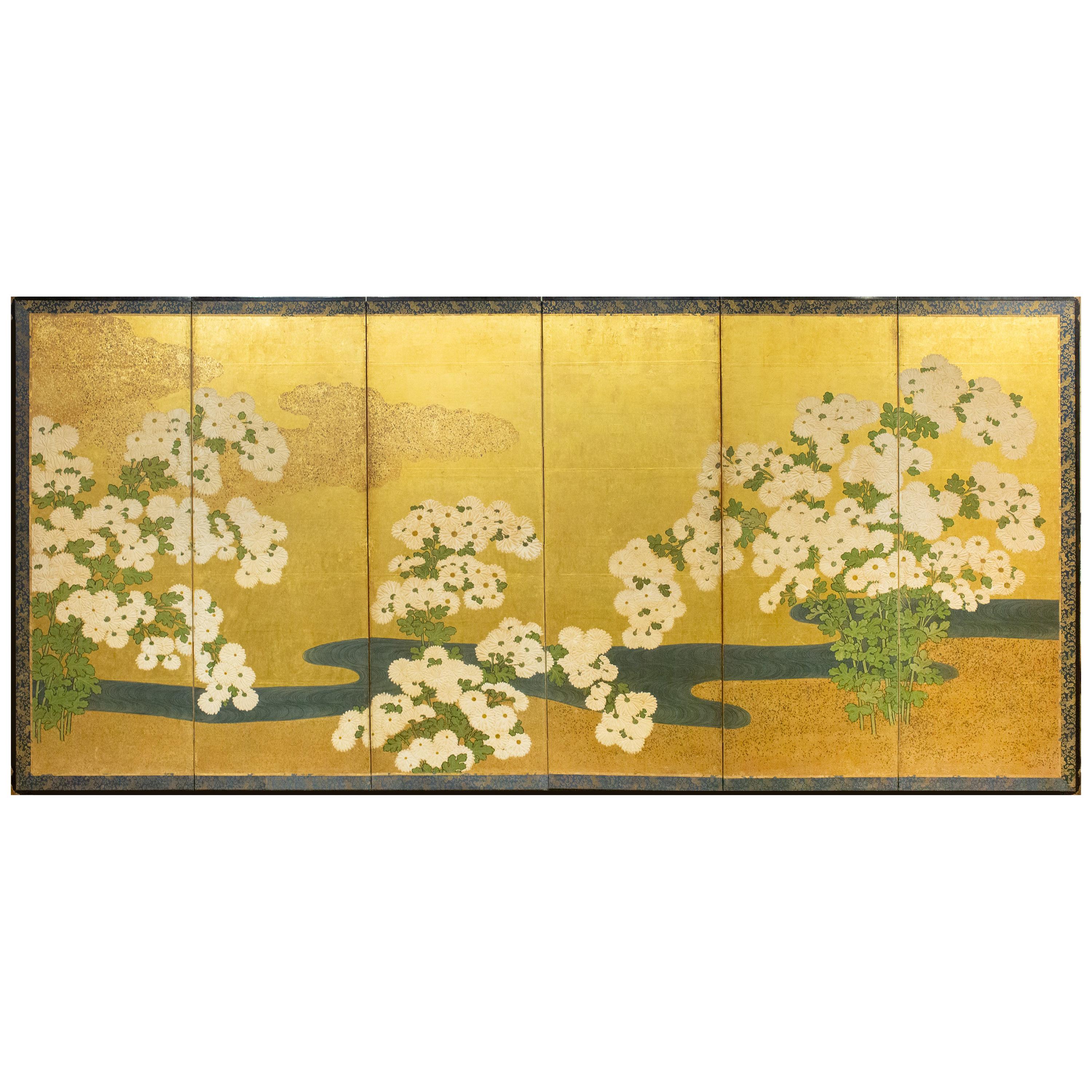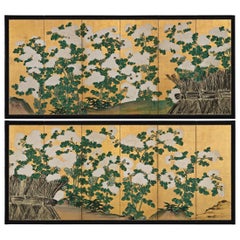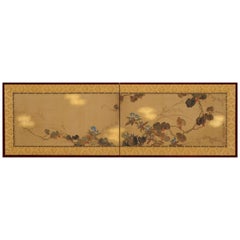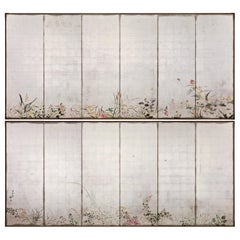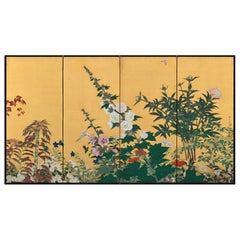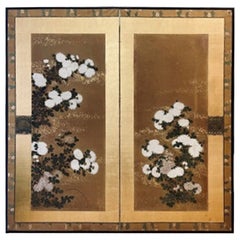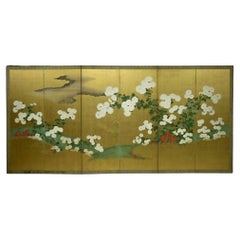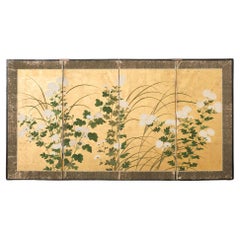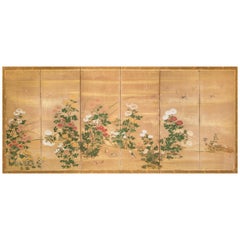Articles similaires à 18th Century Japanese Rinpa Screen. White Chrysanthemums. School of Korin.
Vous voulez plus d'images ou de vidéos ?
Demander au vendeur plus d'images ou de vidéos
1 sur 10
18th Century Japanese Rinpa Screen. White Chrysanthemums. School of Korin.
28 230,79 €
À propos de cet article
School of Ogata Korin
White Chrysanthemums
18th Century, Edo period.
A two-panel Japanese screen. Ink, color, gofun and gold leaf on paper.
Dimensions: H. 171 cm x W. 188 cm (67.5” x 74”)
On this two-panel Japanese screen we see blooming chrysanthemums, a flower which embodies the essence of autumn in Japan. Here the traditional floral theme has been simplified and stylized. The bright colors and asymmetrical composition against the delicate gold leaf create a luxurious and ornate work of art. Its background, a strikingly patinated grid of gold leaf, denies any sense of place or time and imbues everything with an ethereal glow. The leaves and stems of the plants are nothing more than pools of mottled color and ink without any outline whatsoever. These are typical Rinpa adaptations of traditional ink painting methods; tarashikomi, or diluted washes of color blended while very wet, and mokkotsu, or “bonelessness,” which creates forms without exterior outlines. The relief work of the rounded flower petals has been obtained by the moriage process (a mixture based on ground shells modeled on the surface of the paper).
On the lower right of the screen, the siganture “Hokyo Korin Jakumyo” and the “Hoshuku” seal can be read. Korin is Ogata Korin, famed for the Irises (Nezu Museum) and Red and White Plum Blossom (MOA Museum of Art) folding screens, both National Treasures. Korin worked in both Kyoto and Edo in the mid-Edo period. Korin was using the art name “Jakumyo” just after he received the Hokyo level, which was in 1701.
This particular screen was published in May of 1961 in the Japanese Sansai Fine Art Magazine*. An in depth article accompanies the photograph of the screen and and a photograph of the signature and seal. This article devotes much of its body to discussing the moriage technique, how it enlivens the chrysanthemum flowers and Korin’s specific skill in using the technique. The article goes on to discuss the most famous works of Korin, utilizing this technique, which were known at the time. Specifically a two-panel screen held in the Honolulu Museum which was discovered in the store-house of Takahashi Soan. A two-panel screen pair which the Nakano family own. A two-panel screen pair with chrysanthemums in moriage in fan designs owned by the Nomura family. Also a small folding screen featuring chrysanthemums held in the Yamato Bunkakan. The article goes on to say that this particular two-fold screen came from the Nijo family. Korin is known to have had a strong connection with the aristocratic Nijo family. The article explains that Korin received a lot of favors from the Nijo family and that this screen would have been gifted to them.
Since that time the Honolulu screen has been amended to ‘attributed to Ogata Korin’ and I do not know further details of the other 3 screens. Other Chrysanthemum screens utilizing the moriage technique signed and sealed Korin are held in the Guimet Museum, Smithsonian National Museum of Asian Art, Cleveland Museum of Art and the Okada Museum. The pair held in the Cleveland Museum of Art is listed as “Possibly by Ogata Korin”. The pair in the Smithsonian National Museum of Asian Art are dated to the 19th century with no attribution. The Suntory Museum holds a two-panel screen “Flowering Plants in Autumn” which features chrysanthemums in the moriage technique. This work is also “attributed to Ogata Korin”.
It is quite clear that there are serious difficulties in authenticating all of the chrysanthemum screens bearing the signatures and seals of Ogata Korin. The work being offered here clearly dates to the 18th century though is not by the hand of Ogata Korin himself. Perhaps ‘Studio of Korin’ would be appropriate. Perhaps ‘School of Korin’ would be appropriate.
*美術雑誌 三彩 1961(昭和36)年5月 138号
- Dimensions:Hauteur : 171,45 cm (67,5 po)Largeur : 187,96 cm (74 po)Profondeur : 1,91 cm (0,75 po)
- Style:Edo (De la période)
- Matériaux et techniques:
- Lieu d'origine:
- Période:
- Date de fabrication:Circa 1750
- État:Usure conforme à l'âge et à l'utilisation.
- Adresse du vendeur:Kyoto, JP
- Numéro de référence:1stDibs : LU2472343391742
À propos du vendeur
5,0
Vendeur reconnu
Ces vendeurs prestigieux sont des leaders du secteur. Ils représentent le summum en matière de qualité et de design.
Établi en 2001
Vendeur 1stDibs depuis 2016
70 ventes sur 1stDibs
Temps de réponse habituel : 6 heures
- ExpéditionRecherche du devis...Expédition depuis : Kyoto, Japon
- Politique des retours
Certaines parties de cette page ont été traduites automatiquement. 1stDibs ne garantit pas l'exactitude des traductions. L'anglais est la langue par défaut de ce site web.
Garantie d'authenticité
Bien qu'il soit peu probable que la situation se présente, dans le cas où vous rencontreriez un problème d'authenticité d'un article, contactez-nous dans un délai d'un an pour obtenir un remboursement intégral. DétailsGarantie de remboursement
Si votre article n'est pas conforme à la description, est endommagé pendant le transport ou ne vous est pas livré, contactez-nous sous 7 jours pour obtenir un remboursement intégral. DétailsAnnulation sous 24 heures
Vous disposez d'un délai de 24 heures pour annuler votre achat sans motif.Des vendeurs professionnels agréés
Nos vendeurs de renommée mondiale doivent respecter des normes strictes en matière de service et de qualité, afin de préserver l'intégrité de nos fiches produit.Garantie d'alignement des prix
Si vous constatez qu'un autre vendeur a mis en vente le même article à un prix inférieur sur un autre site, nous nous alignerons sur ce prix.Livraison en toute confiance à l'international
Notre réseau de transporteurs de premier ordre propose des options d'expédition spécialisées dans le monde entier, y compris des livraisons personnalisées.Plus d'articles de ce vendeur
Tout afficherPaire de paravents japonais du milieu du XVIIIe siècle, Cent fleurs, chrysanthèmes
Omori Soun (né en 1704)
Chrysanthèmes - Cent fleurs
Paire de paravents japonais à six volets. Encre, couleur, gofun et feuille d'or sur papier.
Datant du milieu du XVIIIe siècle, ...
Catégorie
Antiquités, Milieu du XVIIIe siècle, Japonais, Edo, Peinture et sérigraphie
Matériaux
Feuille d'or
Peinture japonaise sur écran:: début du 19e siècle:: Fleurs d'automne par Sakai Hoitsu
Un écran japonais à deux volets de l'artiste de l'école Rimpa Sakai Hoitsu (1761-1828), Japon, XIXe siècle, période Edo.
Ce petit écran pliant japon...
Catégorie
Antiquités, Début du XIXe siècle, Japonais, Edo, Peinture et sérigraphie
Matériaux
Bois, Soie
Paravents japonais en argent datant d'environ 1930 par Isoi Joshin, Flowers of the Four Seasons
Fleurs des quatre saisons
Isoi Joshin (1883-1964)
Paire de paravents japonais à six panneaux
Encre, pigment, laque et feuille d'argent sur papier
Inscription : Isoi Jo
...
Catégorie
Milieu du XXe siècle, Asiatique, Showa, Peinture et sérigraphie
Matériaux
Feuille d'argent
Écran japonais du début du 20e siècle. Fleurs des Four Seasons.
Anonyme
Fleurs des quatre saisons
Un écran japonais à quatre panneaux. Encre, gofun et pigments sur feuille d'or.
Ce paravent japonais est une riche célébration visuelle des fleurs...
Catégorie
Début du 20ème siècle, Japonais, Taisho, Peinture et sérigraphie
Matériaux
Feuille d'or
Paravent japonais en forme de fleur de cerisier du début du 20e siècle par Kano Sanrakuki
Fleurs de cerisier
Kano Sanrakuki (1898-1981)
Période Showa, vers 1930
Écran japonais à 2 panneaux
Couleur, gofun et feuille d'or sur papier
Sur un fond de feuilles d'...
Catégorie
Début du 20ème siècle, Japonais, Showa, Peinture et sérigraphie
Matériaux
Feuille d'or
Paire de paravents japonais du XIXe siècle. Fleurs et oiseaux des quatre saisons.
Fleurs et oiseaux des quatre saisons
Paire de Foldes japonais à six volets. Encre, couleur, gofun et or sur papier.
Deuxième moitié du 19e siècle
Paire de paravents japonais de ta...
Catégorie
Antiquités, Fin du XIXe siècle, Japonais, Meiji, Peinture et sérigraphie
Matériaux
Bois, Papier
Suggestions
Paravent japonais d'époque Edo à deux panneaux avec chrysanthèmes, vers 1750
Paravent japonais d'époque Edo à deux panneaux avec chrysanthèmes, vers 1750
À PROPOS DE
Cet écran est en effet un chef-d'œuvre de design et de composition avec un cadre en...
Catégorie
Antiquités, XIXe siècle, Japonais, Japonisme, Peinture et sérigraphie
Matériaux
Bois
Écran à fleurs de chrysanthème de l'école Rinpa de la fin de la période Edo
Par Rimpa School
Écran à fleurs de chrysanthème de l'école Rinpa de la fin de la période Edo
Période : fin Edo, début 19ème siècle
Taille : 364 x 172 cm (143 x 67 pouces)
SKU : PTA13
Cet exquis par...
Catégorie
Antiquités, XVIIIe siècle, Japonais, Edo, Peinture et sérigraphie
Matériaux
Papier
8 448 €
Livraison gratuite
Écran japonais Edo à quatre panneaux de chrysanthèmes blancs fleuris
Extraordinaire paravent byobu à quatre panneaux de la fin de la période Edo/début de la période Meiji, datant du 19e siècle, représentant des chrysanthèmes blancs en fleurs, peints d...
Catégorie
Antiquités, XIXe siècle, Japonais, Edo, Peinture et sérigraphie
Matériaux
Laiton, Feuille d'or
Paravent japonais à six panneaux, chrysanthèmes
Paravent japonais à six panneaux : Chrysanthèmes, peinture de la période Edo (vers 1800) représentant une variété de chrysanthèmes dans un paysage de jardin, avec des moineaux. Pigme...
Catégorie
Antiquités, Début des années 1800, Japonais, Edo, Peinture et sérigraphie
Matériaux
Feuille d'or
Paravent japonais à six panneaux, Rimpa School Chrysanthèmes sur or
Une utilisation abondante de l'or avec des chrysanthèmes magnifiquement drapés et des nuages en paillettes d'or. Pigments minéraux, go fun, feuille d'or sur papier mûrier avec une bo...
Catégorie
Antiquités, Début du XIXe siècle, Japonais, Meiji, Peinture et sérigraphie
Matériaux
Feuille d'or
Paravent japonais à deux panneaux : Chrysanthèmes sur une clôture de branchages
Pigment minéral et poussière d'or sur papier mûrier. Bordure en brocart de soie et garniture en laque noire. De la Collection S de Moke Mokotoff
Catégorie
Antiquités, Fin du XIXe siècle, Japonais, Peinture et sérigraphie
Matériaux
Or

